Resolving and Analyzing Landfast Ice Deformation by InSAR Technology Combined with Sentinel-1A Ascending and Descending Orbits Data
Abstract
1. Introduction
2. Data and Materials
3. Methods
3.1. InSAR Data Processing
3.2. Extracting Fast Ice Boundary
3.3. Calculating the Horizontal and Vertical Deformation
4. Results
4.1. Coherence Images
4.2. Interferograms
4.3. Deformation Maps
5. Discussions and Analysis
5.1. Factors of Decorrelation
5.2. Characteristics of Interferograms
5.3. Deformation Factors
5.4. Comparison with Previous Works
6. Conclusions
Author Contributions
Funding
Acknowledgments
Conflicts of Interest
References
- Leppäranta, M. Land-ice interaction in the Baltic Sea. Est. J. Earth Sci. 2013, 62, 2–14. [Google Scholar] [CrossRef]
- Granskog, M.; Kaartokallio, H.; Kuosa, H.; Thomas, D.N.; Vainio, J. Sea ice in the Baltic Sea—A review. Estuar. Coast. Shelf Sci. 2006, 70, 145–160. [Google Scholar] [CrossRef]
- Dammann, D.O.; Eicken, H.; Mahoney, A.R.; Meyer, F.J.; Freymueller, J.T.; Kaufman, A.M. Evaluating landfast sea ice stress and fracture in support of operations on sea ice using SAR interferometry. Cold Reg. Sci. Technol. 2018, 149, 51–64. [Google Scholar] [CrossRef]
- Dammann, D.O.; Eicken, H.; Meyer, F.J.; Mahoney, A.R. Assessing small-scale deformation and stability of landfast sea ice on seasonal timescales through L-band SAR interferometry and inverse modeling. Remote Sens. Environ. 2016, 187, 492–504. [Google Scholar] [CrossRef]
- Mesher, D.; Proskin, S.; Madsen, E. Ice Road Assessment, Modeling and Management. In Proceedings of the 7th International Conference on Managing Pavement Assets, Calgary, AB, Canada, 23–28 June 2008. [Google Scholar]
- Laxon, S.W.; Giles, K.A.; Ridout, A.L.; Wingham, D.J.; Willatt, R.; Cullen, R.; Kwok, R.; Schweiger, A.; Zhang, J.; Haas, C.; et al. CryoSat-2 estimates of Arctic sea ice thickness and volume. Geophys. Res. Lett. 2013, 40, 732–737. [Google Scholar] [CrossRef]
- Berg, A.; Dammert, P.; Eriksson, L.E. X-Band Interferometric SAR Observations of Baltic Fast Ice. IEEE. Trans. Geosci. Remote Sens. 2015, 53, 1248–1256. [Google Scholar] [CrossRef]
- Marbouti, M.; Praks, J.; Antropov, O.; Rinne, E.; Leppäranta, M. A Study of Landfast Ice with Sentinel-1 Repeat-Pass Interferometry over the Baltic Sea. Remote Sens. 2017, 9, 833. [Google Scholar] [CrossRef]
- Dammert, P.B.G.; Lepparanta, M.; Askne, J. SAR interferometry over Baltic Sea ice. Int. J. Remote Sens. 1998, 19, 3019–3037. [Google Scholar] [CrossRef]
- Meyer, F.J.; Mahoney, A.R.; Eicken, H.; Denny, C.L.; Druckenmiller, H.C.; Hendricks, S. Mapping arctic Landfast ice extent using L-band synthetic aperture radar interferometry. Remote Sens. Environ. 2011, 115, 3029–3043. [Google Scholar] [CrossRef]
- Hu, J.; Li, Z.; Ding, X.; Zhu, J.; Zhang, L.; Sun, Q. Resolving three-dimensional surface displacements from insar measurements: A review. Earth Sci. Rev. 2014, 133, 1–17. [Google Scholar] [CrossRef]
- Galloway, D.L.; Hudnut, K.W.; Ingebritsen, S.E.; Philips, S.P.; Peltzer, G.; Rogez, F.; Rosen, P.A. Detection of aquifer system compaction and land subsidence using interferometric synthetic aperture radar, Antelope Valley, Mojave Desert, California. Water Resour. Res. 1998, 34, 2573–2585. [Google Scholar] [CrossRef]
- Amelung, F.; Galloway, D.L.; Bell, J.W.; Zebker, H.A.; Laczniak, R.J. Sensing the ups and downs of Las Vegas: InSAR reveals structural control of land subsidence and aquifer-system deformation. Geology 1999, 27, 483–486. [Google Scholar] [CrossRef]
- Hung, W.C.; Hwang, C.; Chen, Y.A.; Chang, C.P.; Yen, J.Y.; Hooper, A.; Yang, C.Y. Surface deformation from persistent scatterers SAR interferometry and fusion with leveling data: A case study over the Choushui River Alluvial Fan, Taiwan. Remote Sens. Environ. 2011, 115, 957–967. [Google Scholar] [CrossRef]
- Mora, O.; Ordoqui, P.; Iglesias, R.; Blanco, P. Earthquake rapid mapping using ascending and descending Sentinel-1 TOPSAR interferograms. Procedia Comput. Sci. 2016, 100, 1135–1140. [Google Scholar] [CrossRef]
- Wright, T.J.; Parsons, B.E.; Lu, Z. Toward mapping surface deformation in three dimensions using InSAR. Geophys. Res. Lett. 2004, 31, L01607. [Google Scholar] [CrossRef]
- Raucoules, D.; de Michele, M.; Malet, J.P.; Ulrich, P. Time-variable 3D ground displacements from high-resolution synthetic aperture radar (SAR). Application to La Valette landslide (South French Alps). Remote Sens. Environ. 2013, 139, 198–204. [Google Scholar] [CrossRef]
- Hu, J.; Ding, X.L.; Li, Z.W.; Zhang, L.; Zhu, J.J.; Sun, Q.; Gao, G.J. Vertical and horizontal displacements of Los Angeles from InSAR and GPS time series analysis: Resolving tectonic and anthropogenic motions. J. Geodyn. 2016, 99, 27–38. [Google Scholar] [CrossRef]
- Leppäranta, M. On the structure and mechanics of pack ice in the Bothnian Bay. Finn. Mar. Res. 1981, 248, 3–86. [Google Scholar]
- Karvonen, J. Baltic sea ice concentration estimation based on C-band dual-polarized SAR data. IEEE Trans. Geosci. Remote Sens. 2014, 52, 5558–5566. [Google Scholar] [CrossRef]
- Shi, J.; Dozier, J. Estimation of snow water equivalence using SIR-C/X-SAR. II. Inferring snow depth and particle size. IEEE Trans. Geosci. Remote Sens. 2000, 38, 2475–2488. [Google Scholar]
- Sentinel-1 User Handbook, Sentinel-1 Team. pp. 1–80. Available online: https://sentinel.esa.int/documents/247904/685163/Sentinel-1_User_Handbook (accessed on 20 January 2020).
- ACE2 DEM, A Data Center in NASA’s Earth Observing System Data and Information System (EOSDIS). Available online: https://sedac.ciesin.columbia.edu/data/set/dedc-ace-v2/data-download (accessed on 24 February 2020).
- Ice Chart, Swedish Meteorological and Hydrological Institute, Ice Conditions. February 2018. Available online: http://www.smhi.se/klimatdata/oceanografi/havsis (accessed on 24 February 2020).
- Meteorological Information, Finland Meteorological Institute, Weather and Sea. February 2018. Available online: https://en.ilmatieteenlaitos.fi/weather-and-sea (accessed on 18 March 2020).
- Ajos, Kemi Airport. February 2018. Available online: https://www.timeanddate.com/weather/@661668/historic?month=2&year=2018 (accessed on 18 March 2020).
- Bamler, R.; Hartl, P. Synthetic aperture radar interferometry. Inverse Probl. 1998, 14, R1–R54. [Google Scholar] [CrossRef]
- Rosen, P.A.; Hensley, S.; Joughin, I.R.; Li, F.K.; Madsen, S.N.; Rodriguez, E.; Goldstein, R.M. Synthetic aperture radar interferometry. Proc. IEEE 2000, 88, 333–382. [Google Scholar] [CrossRef]
- Lee, J.-S. A simple speckle smoothing algorithm for synthetic aperture radar images. IEEE Trans. Syst. Man Cybern. 1983, 13, 85–89. [Google Scholar] [CrossRef]
- Goldstein, R.M.; Werner, C.L. Radar interferogram filtering for geophysical applications. Geophys. Res. Lett. 1998, 25, 4035–4038. [Google Scholar] [CrossRef]
- Costantini, M. A novel phase unwrapping method based on network programming. IEEE Trans. Geosci. Remote Sens. 1998, 36, 813–821. [Google Scholar] [CrossRef]
- Karvonen, J. Evaluation of the operational SAR based Baltic Sea ice concentration products. Adv. Space Res. 2015, 56, 119–132. [Google Scholar] [CrossRef]
- Otsu, N. A Threshold Selection Method from Gray-Level Histograms. IEEE Trans. Syst. Man Cybern. 2007, 9, 62–66. [Google Scholar] [CrossRef]
- National Oceanic and Atmospheric Administration, NOAA GSHHG Data Version 2.3.7. Available online: https://www.ngdc.noaa.gov/mgg/shorelines/data/gshhg/latest/ (accessed on 14 December 2019).
- Rocca, F. 3D motion recovery with multi-angle and/or left right interferometry. In Proceedings of the 3rd International Workshop on ERS SAR, Frascati, Italy, 1–5 December 2003. [Google Scholar]
- Hu, J.; Li, Z.; Ding, X.; Zhu, J.; Zhang, L.; Sun, Q. 3D coseismic displacement of 2010 Darfield, New Zealand earthquake estimated from multi-aperture InSAR and D-InSAR measurements. J. Geodesy 2012, 86, 1029–1041. [Google Scholar] [CrossRef]
- Shirzaei, M. A seamless multitrack multitemporal InSAR algorithm. Geochem. Geophys. Geosyst. 2015, 16, 1656–1669. [Google Scholar] [CrossRef]
- Timco, G.; Weeks, W. A review of the engineering properties of sea ice. Cold Reg. Sci. Technol. 2010, 60, 107–129. [Google Scholar] [CrossRef]
- Kim, J.H.; Park, J.; Hong, S.; Won, J. Interferometric analysis of quad-pol SAR data for observation of sea ice dynamics. In Proceedings of the IEEE IGARSS, Milan, Italy, 26–31 July 2015; pp. 3430–3433. [Google Scholar]
- Zhang, X.; Zhang, J.; Meng, J.; Wang, Z. Sea ice detection with TanDEM-X SAR data in the Bohai Sea. In Proceedings of the IEEE IGARSS, Beijing, China, 10–15 July 2016; pp. 346–349. [Google Scholar]
- Fjortoft, R.; Gaudin, J.M.; Pourthie, N.; Lalaurie, J.C.; Mallet, A.; Nouvel, J.F.; Martinot-Lagarde, J.; Oriot, H.; Borderies, P.; Ruiz, C. Karin on SWOT: Characteristics of near-nadir ka-band interferometric SAR imagery. IEEE Trans. Geosci. Remote Sens. 2014, 52, 2172–2185. [Google Scholar] [CrossRef]
- Vaze, P.; Kaki, S.; Limonadi, D.; Esteban-Fernandez, D.; Zohar, G. The surface water and ocean topography mission. In Proceedings of the IEEE Aerospace Conference, Big Sky, MT, USA, 3–10 March 2018; pp. 1–9. [Google Scholar]
- Zhang, Y.; Dong, X.; Shi, X.; Zhai, W.; Yang, Q.; Li, D.; Kang, X.; Jiang, J. Demonstration of ocean target detection by Tiangong-2 interferometric imaging radar altimeter. In Proceedings of the 22nd IEEE International Microwave and Radar Conference, Poznan, Poland, 14–17 May 2018; pp. 261–264. [Google Scholar]
- Zhang, Y.; Shi, X.; Wang, H.; Tan, Y.; Zhai, W.; Dong, X.; Kang, X.; Yang, Q.; Li, D.; Jiang, J. Interferometric Imaging Radar Altimeter on Board Chinese Tiangong-2 Space Laboratory. In Proceedings of the Asia-Pacific Microwave Conference (APMC), Kyoto, Japan, 6–9 November 2018; pp. 851–853. [Google Scholar]
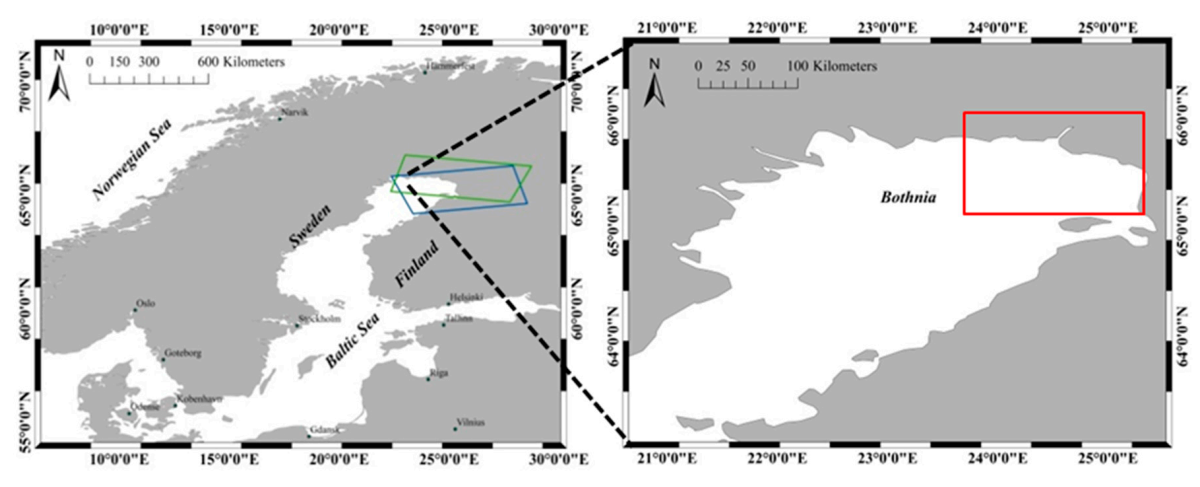
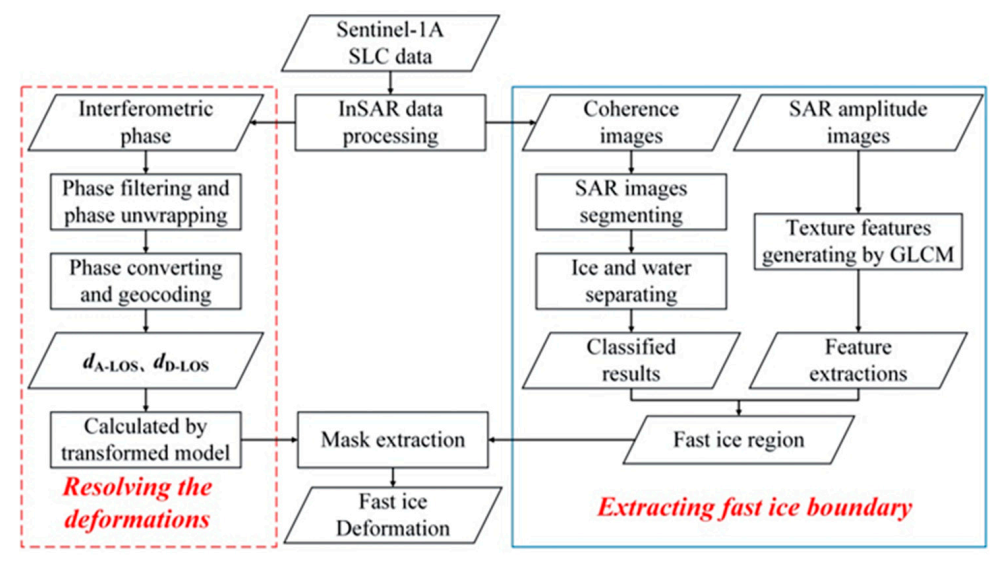
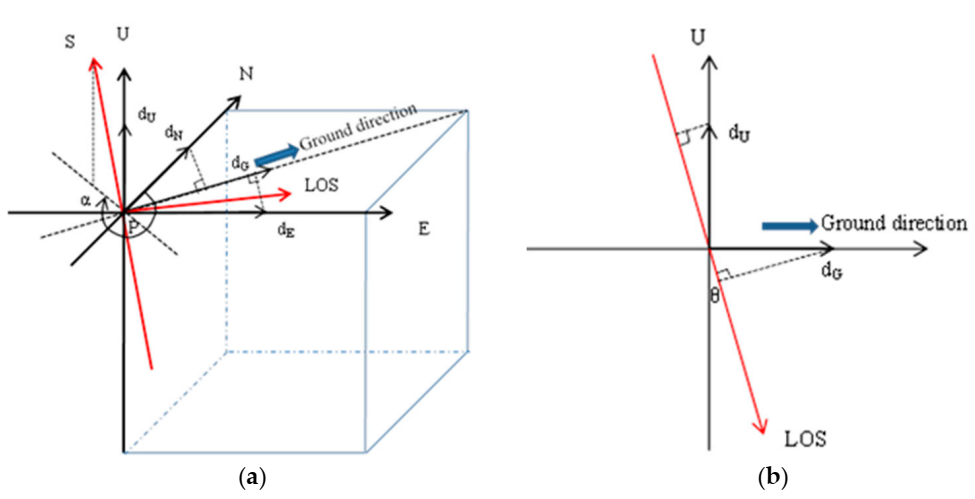
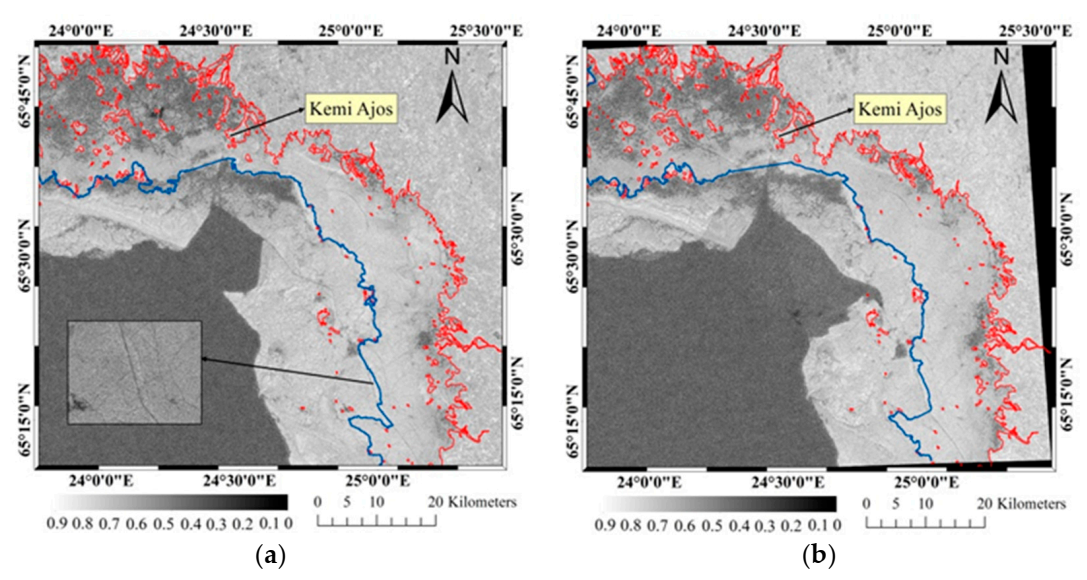
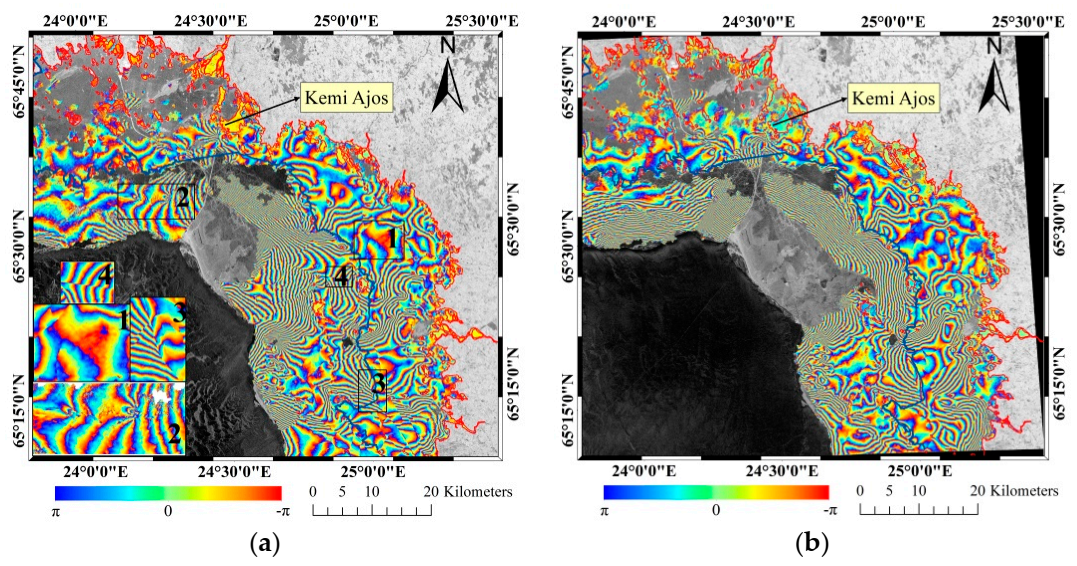
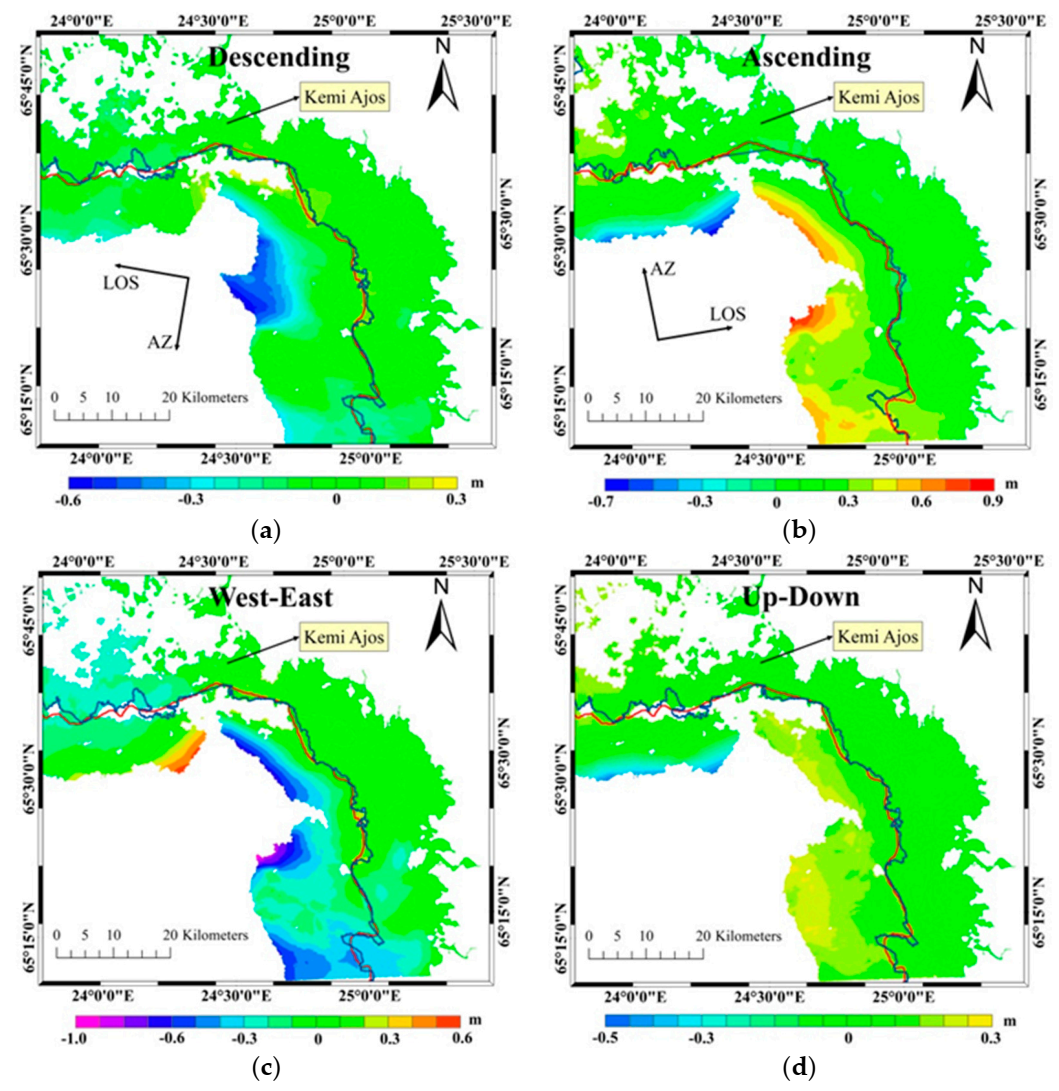

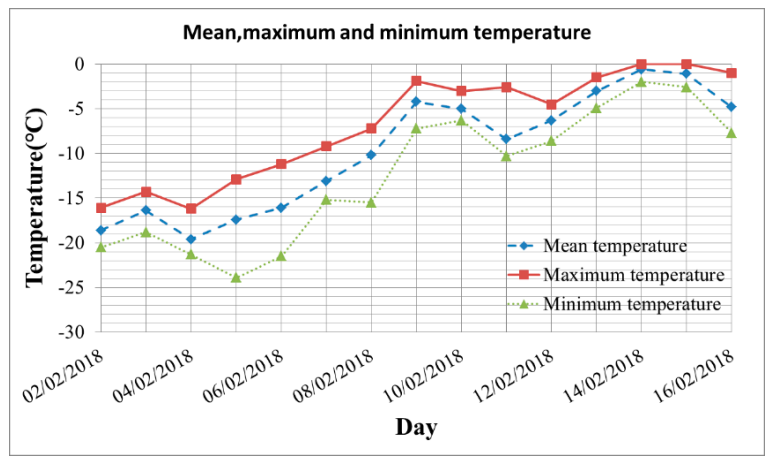

| Characteristic | Value |
|---|---|
| Swath width | 250 km |
| Incidence Angle Range | 29.1°–46.0° |
| Sub-Swath | IW1, IW2, IW3 |
| Azimuth Steering angle | ±0.6° |
| Maximum Noise Equivalent Sigma Zero (NESZ) | −22 dB |
| Radiometric Stability | 0.5 dB (3σ) |
| Radiometric Accuracy | 1 dB (3σ) |
| Phase Error | 5° |
| Spatial resolution | 5 × 20 m |
| Image Pair A | Image Pair B | |
|---|---|---|
| Acquisition dates | 2 February 2018 | 4 February 2018 |
| 14 February 2018 | 16 February 2018 | |
| Local time (UTC) | 04:48 | 15:49 |
| Orbit | Descending | Ascending |
| Look direction | Right | Right |
| Incidence angle | 41.06° | 36.12° |
| Normal baseline | 13.05 m | 61.65 m |
| Polarization | VV | VV |
| Relative orbit | 51 | 87 |
| Directions | Entire Region 1 | Fast ice Region 1 | ||
|---|---|---|---|---|
| Deformation Range/m | Displacement Value/m | Deformation Range/m | Displacement Value/m | |
| LOS (Descending) | −0.61–0.30 | 0.91 | −0.18–0.20 | 0.38 |
| LOS (Ascending) | −0.73–0.85 | 1.58 | −0.07–0.30 | 0.37 |
| West-East | −1.08–0.60 | 1.68 | −0.44–0.26 | 0.70 |
| Up-Down | −0.50–0.31 | 0.81 | −0.03–0.16 | 0.19 |
| Station | Image Pair A | Image Pair B | ||
|---|---|---|---|---|
| First Time | Second Time | First Time | Second Time | |
| Kemi Ajos | −30.5 cm | 4.4 cm | −17.6 cm | −5.1 cm |
| Oulu Toppila | −28.6 cm | 3.4 cm | −16.1 cm | −3.0 cm |
| Deformation Results | Deformation in LOS | Max Vertical Deformation | Max Horizontal Deformation |
|---|---|---|---|
| Study by Berg, A. et al. | 4.7 cm | — | — |
| Result in this paper | 5.3 cm | 1.3 cm | −25 cm |
| Deformation difference | 0.6 cm | — | — |
| Study by Marbouti, M. et al. | 40 cm | — | — |
| Result in this paper | 37 cm | 16 cm | −44 cm |
| Deformation difference | 3 cm | — | — |
Publisher’s Note: MDPI stays neutral with regard to jurisdictional claims in published maps and institutional affiliations. |
© 2020 by the authors. Licensee MDPI, Basel, Switzerland. This article is an open access article distributed under the terms and conditions of the Creative Commons Attribution (CC BY) license (http://creativecommons.org/licenses/by/4.0/).
Share and Cite
Wang, Z.; Liu, J.; Wang, J.; Wang, L.; Luo, M.; Wang, Z.; Ni, P.; Li, H. Resolving and Analyzing Landfast Ice Deformation by InSAR Technology Combined with Sentinel-1A Ascending and Descending Orbits Data. Sensors 2020, 20, 6561. https://doi.org/10.3390/s20226561
Wang Z, Liu J, Wang J, Wang L, Luo M, Wang Z, Ni P, Li H. Resolving and Analyzing Landfast Ice Deformation by InSAR Technology Combined with Sentinel-1A Ascending and Descending Orbits Data. Sensors. 2020; 20(22):6561. https://doi.org/10.3390/s20226561
Chicago/Turabian StyleWang, Zhiyong, Jian Liu, Jinning Wang, Lihua Wang, Meng Luo, Zihao Wang, Ping Ni, and Hao Li. 2020. "Resolving and Analyzing Landfast Ice Deformation by InSAR Technology Combined with Sentinel-1A Ascending and Descending Orbits Data" Sensors 20, no. 22: 6561. https://doi.org/10.3390/s20226561
APA StyleWang, Z., Liu, J., Wang, J., Wang, L., Luo, M., Wang, Z., Ni, P., & Li, H. (2020). Resolving and Analyzing Landfast Ice Deformation by InSAR Technology Combined with Sentinel-1A Ascending and Descending Orbits Data. Sensors, 20(22), 6561. https://doi.org/10.3390/s20226561




